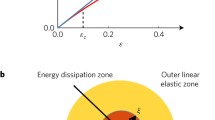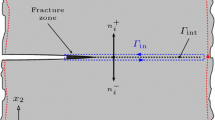Abstract
A quasi-statically growing stable crack, if perturbed from its equilibrium position, will accelerate back towards it. Within quasi-static, ideal, Griffith fracture theory, vibrations of the crack and the structure have characteristic natural frequencies. We explore this feature of Griffith fracture theory in two simple geometries: a crack between a bar and a substrate, and a crack in a double-cantilever beam (DCB) specimen. For small perturbations about the stable quasi-static configuration, the dynamic equations of motion reduce to simple eigenvalue problems, leading to exact expressions for natural frequencies and mode shapes. An interesting feature of the mode shapes is that they correspond to force-free or moment-free conditions at the crack tip. Using an extended form of Hamilton's principle, we have developed a variable-length finite element technique to calculate natural frequencies and mode shapes of deformations perturbed from the stable equilibrium state. Its accuracy is demonstrated by application to the two problems analyzed previously. The possibility of crack tip oscillations in real brittle materials with irreversibility in crack tip decohesion is discussed in light of Rice's generalization of the Griffith theory.
Similar content being viewed by others
References
Syed Asif, S.A., Wahl, K.J., Colton, R.J. and Warren, O.L. (2001). Quantitative imaging of nanoscale mechanical properties using hybrid nanoindentation and force modulation, Journal of Applied Physics 90(3), 1192–1200. Also, private communication, K.J. Wahl.
Bilek Z.J. and Bums S.J. (1974). Crack propagation in wedged double cantilevered beam specimens, Journal of the mechanics and physics of solids 22, 85–95.
Blackman, B.R.K., Kinloch, A.J., Wang, Y. and Williams, J.G. (1998). The failure of fibre composites and adhesively bonded fibre composites under high rates of test. Part ll, Mode I loading-Dynamic effects, Journal of Materials Science 31, 4451–4466.
Burridge, R. and Keller, J.B. (1978). Peeling, slipping and cracking – some one-dimensional free-boundary problems in mechanics, SIAM Review 20, 31–61.
Freund, L.B., (1990). Dynamic fracture mechanics, Cambridge University Press, Cambridge, U.K.
Griffith, A.A. (1920). The phenomena of rupture and flow in solids. Phil. Trans. Royal Soc. A221, 163–198.
Johnson K.L., Kendall K. and Roberts A,D. (1971). Surface energy and the contact of elastic solids Proc. R. Soc. Lond. A324, 301–313.
Lawn, B. (1993). Fracture of Brittle Solids – Second Edition, Cambridge University Press.
Meirovitch, L. (1967). Analytical Methods in Vibrations, Macmillan Publishing Co., Inc. (New York).
Rice, J.R. (1978). Thermodynamics of the quasi-static growth of Griffith cracks, Journal of the Mechanics and Physics of Solids 26, 61–78.
Stylianou, M., Tabarrok, B. (1994). Finite element analysis of an axially moving beam. Part I: Time integration, Journal of Sound and Vibration 178, 433–453.
Wan, K-T. and Lawn, B.R. (1990). Surface forces at crack interfaces in mica in the presence of capillary condensation, Acta Metall. Mater. 38, 2073–2083.
Wan, K-T., Aimard, N., Lathabai, S., Horn R.G. and Lawn B.R. (1990) Interfacial energy states of moistureexposed cracks in mica, Journal of Materials Research 5, 172–182.
Wang, Y. and Williams, J.G. (1994). A numerical study of dynamic crack growth in isotropic DCB specimens, Composites 25, 323–331.
Webb, T.W. and Aifantis, E.C., (1995). Oscillatory fracture in polymeric materials, International Journal of Solids and Structures 32, 2725–2743.
Williams, J.G. (1993). A review of the determination of energy release rates for strips in tension and bending. Part II – Dynamic Solutions, Strain Analysis for Engineering Design 28, 247–256.
Williams, J.G. (1994). High speed delamination of composites, European Journal of Mechanics A/Solids 13, 227–241.
Williams, J.G. (1999). Transient effects during rapid crack propagation, International Journal of Fracture, In Press.
Yang, T.Y. (1986). Finite element structural analysis, Prentice-Hall, Inc., Englewood Cliffs, New Jersey 07632.
Author information
Authors and Affiliations
Rights and permissions
About this article
Cite this article
Jagota, A., Rahul-Kumar, P. & Saigal, S. Natural Frequencies of Stable Griffith Cracks. International Journal of Fracture 116, 103–120 (2002). https://doi.org/10.1023/A:1020134204606
Issue Date:
DOI: https://doi.org/10.1023/A:1020134204606




